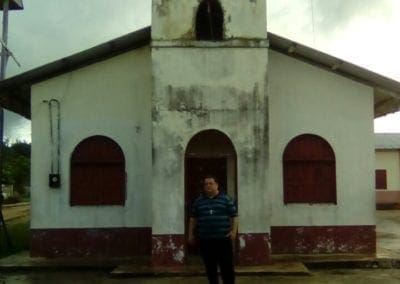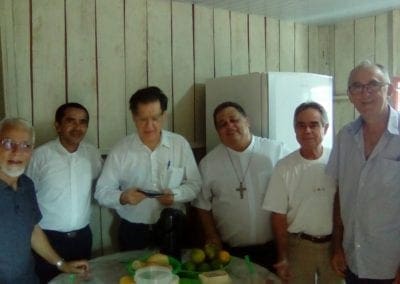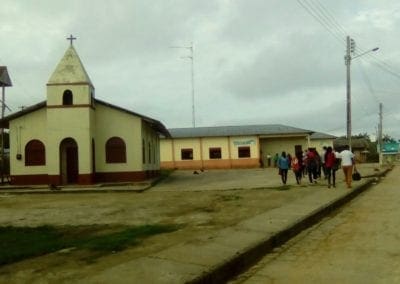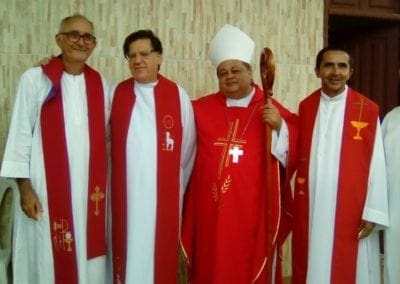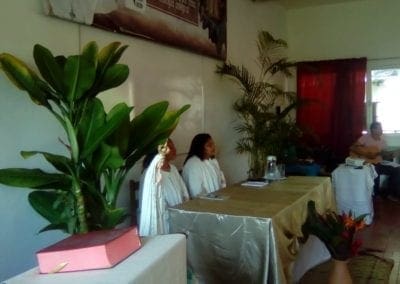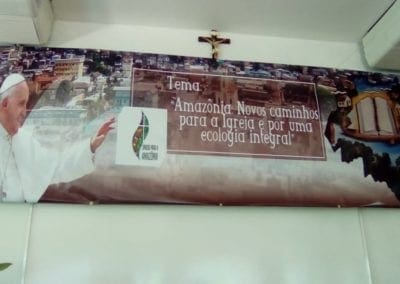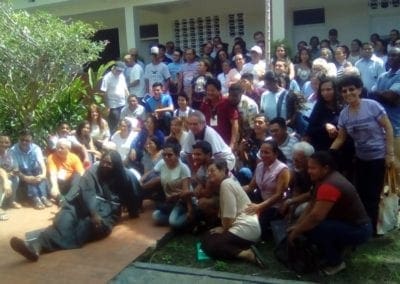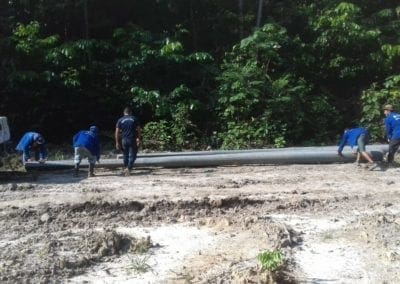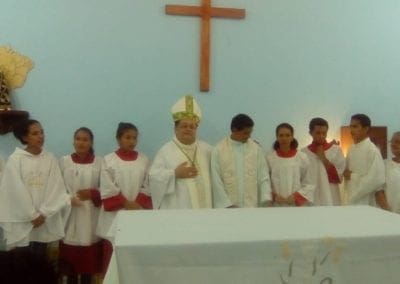“Depart … Depart, walk, leave everything, leave, Break the coast of selfishness which closes us in oneself. Depart without fear…” (Dom Helder Camara)
When you fly over the Amazonia, the people who arrive, mainly missionaries, filled with curiosity and expectations, cannot imagine what they will find in that jungle, crossed by many large rivers. So they have gotten information or researched or read, they cannot imagine the complexity of life in that immense territory with several “Amazonías”, given the great diversity. As they get deeper into that biodiversity, living with this reality, nature, inhabitants, their customs and culture, they gradually come to know what happens in this world with a past and a present wrapped around in adventures, stories, myths and legends. It is known that the Amazonia is still shown as “an enigma that must be deciphered”. Therefore, this reality cannot be approached with a simplistic, folkloric, stereotyped, or exotic view, or viewed as a backward culture, or as an immense farm of water and mineral resources for the world.
Amazonia always presents challenging, because of its great geographic distances where its population is spread, with precarious means of transport and communication, and basic attention, making any activity difficult there.
In the religious aspect, in addition to the beliefs of the traditional peoples, the Catholic Church is present, as much as many Pentecostal Evangelical denominations, which are in growing continuously. It was Catholicism to reach these lands first with missionaries, starting in the seventeenth century, establishing towns and cities on the rivers banks.
Leaving their homeland, many missionaries entered into rivers and jungle, with a missionary spirit marked by the dedication and commitment of their own lives. But from the Evangelization project of that time, prevailing doctrinal rigor and sacramental practice, established a dualism between what was proposed and what people lived. Catholicism emerged from that relationship “became practiced without the presence of clergy,” without the need for mediation of a priest and a lay leadership.
Due to large government projects in the 70s, economic growth and integration of the Amazonia with the rest of the country was noticed. there was a process of migration to the rest of the country and a large influx of people from other regions of the country to the Amazonia. The consequence of this fact started to be called “Urbanization of Poverty”.
In this development process, the hundred-year-old city of Tefé experienced a growth leading to expansion, creating new neighborhoods and overpopulating older ones. One of them, traditional and close to the center of the city, is the densely populated Abial neighborhood, where our International Mission is located. It’s a small elevation next to the lake Tefé and crossed by the small river Xidarini. During rain season it can be accessed in small motorized boats (“rabetas or catraias”) which carry about 8 people. Disembarking, a view you can immediately have is shocking. Asphalt paved streets are in poor condition, causing the sewer system to be exposed. Houses, well linked to each other, do not offer space for privacy and adequate hygiene conditions, sometimes giving room to promiscuity.
There are three schools, one municipal and two state owned. All are in good condition and many students enjoy the comfort of study and sports. In any case, the search for survival leads young people to bet on the easiest, most immediate and most illicit means of earning for a living, generating a vicious circle in which violence is present.
Going through Amazonia, and especially in the state of Amazonas, is stepping into a markedly indigenous land. The same takes place Abial. The majority of the people, using their physical features, show the beauty and marks of their indigenous ancestors. In the same way they show their customs, the way of building the houses – especially in wood and on poles (palafitos) – in their habits, in their food, in the religious manifestations and in the ways they coexist.
The parish of Abial, created ten years ago, is made up of four communities: the main church, with a good space for ministry; the other three communities are located within walking distance from the heart of the parish: one is in the upper part of the neighborhood – community of Christ the King – another, in a fishermen colony – Christ the Redeemer community – and the third, in a recent occupied urban ne – Saint Vincent de Paul community – fruit of the recent Vincentian presence.
The vitality of these communities is striking, because of the number of participants from the small group of people which is frequently demonstrated during preparation and realization of the celebrations, during catechesis and in the responsibility to maintain and preserve the community. There was a great effort to endow the parish with a good material structure, fruit of community work which develops the sense of belonging.
After eight months of living in the neighborhood of Abial, this reality must be taken into account. It was important to think about how to run pastoral ministry respecting history, culture, identity and the manifestations of its inhabitants.
It is important to keep in mind the words of then Cardinal Jorge Bergoglio, before e became the Pope about “outgoing and broken Church”, which reminded us that “a transcendent look of faith” is important to observe or perceive who is behind a reality like that. This view involves situation of specific people, their history, their culture, their identity and religion. Our presence as a Congregation of the Mission here, will demand a use of all means to dismantle our fears and not to create in us a feeling of pastoral impotence: human maturity and faith, in which humility helps us to learn, patience in walking with people and communities and respect in that journey will enable an important and fruitful dialog for the proclamation of the Kingdom a mystic proper for the region, in agreement with the Episcopal Commission for the Amazon of the CNBB (National Conference of Bishops of Brazil).
by Fr. Paulo Venuto, CM

